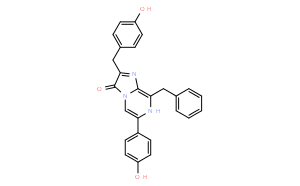
 COA COA |
 MSDS MSDS |
 HPLC HPLC |
 NMR NMR |
| CAS No: | 55779-48-1 |
| Molecular formula(MF) | C26H21N3O3 |
| Molecular Weight(MW): | 423.46 |
| Alias | 2-[(4-Hydroxyphenyl)methyl]-6-(4-hydroxyphenyl)-8-(phenylmethyl)-imdazo[1,2-a]pyrazin-3-(7H)-one; 8-Benzyl-2-(4-hydroxybenzyl)-6-(4-hydroxyphenyl)imidazo[1,2-a]pyrazin-3(7H)-one; Coelenterazine |
| In vitro | DMSO | 84 mg/mL (198.36 mM) |
|---|---|---|
| Ethanol | 1 mg/mL (2.36 mM) | |
| Water | <1 mg/mL | |
| In vivo |
| Description | Coelenterazine is a luminescent enzyme substrate, used for monitoring reporter genes in BRET, ELISA and HTS techniques. |
|---|---|
| In vitro |
When monitoring various biological processes, coelenterazine (CTZ) can be catalyzed by luciferases, such as the sea pansy Renilla reniformis (Rluc) and the marine copepod Gaussia princeps (Gluc), which results in emission of blue light. In Gli36-Gluc- or Gli36-Rluc-expressing Gli36 cells, coelenterazine (8 礸/ml) shows a bioluminescence signal. [1] In RIN-5F, 4T1, HCT 116, HEK 293, 293FT, HeLa and INS-1 cells, coelenterazine can be used to assay superoxide anion concentrations. [2] |
| In vivo | In 4T1-implanted mouse, Coelenterazine detects cancer-associated superoxide anion and used to evaluate the role of superoxide anion in cancer cell biology and its role in pathology. [2] |